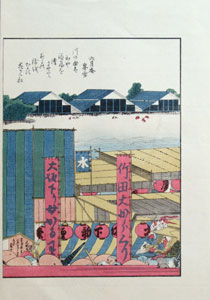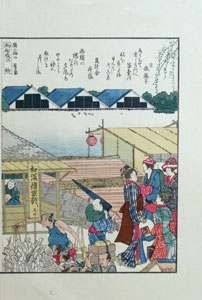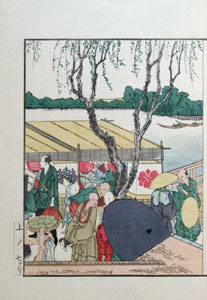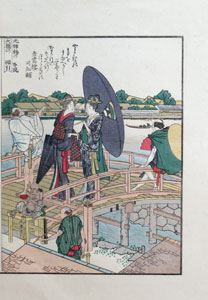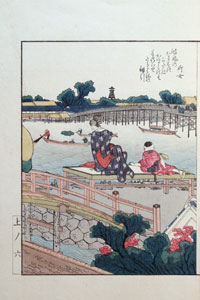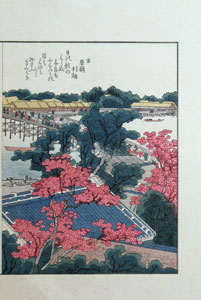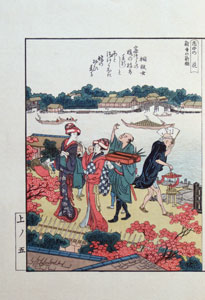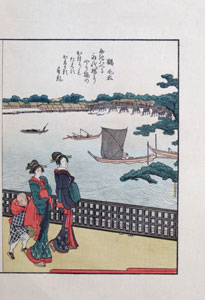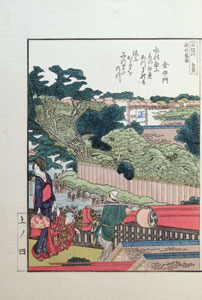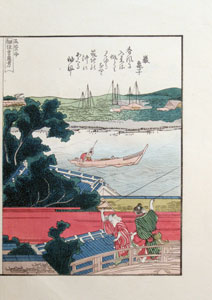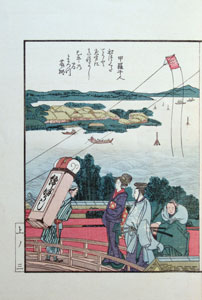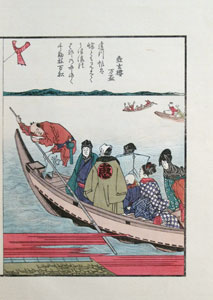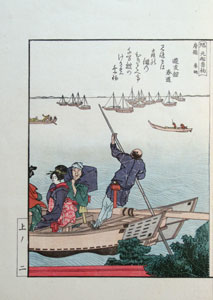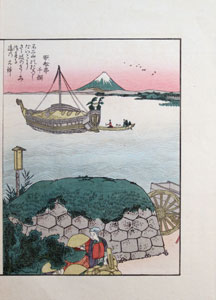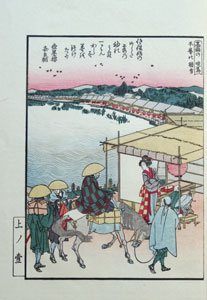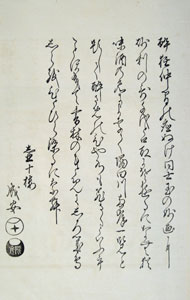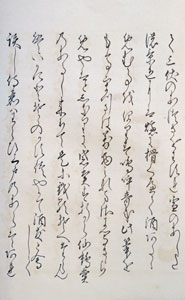Edo prints
| Design: | Katsushika Hokusai (1760-1849) | |||||
| Title: | Ehon Sumida Gawa Ryōgan Ichiran Jō | |||||
| Size: | 30 x 21 cm | |||||
| Posthumous printing from newly cut woodblocks | ||||||
| Photography: | Jacques Commandeur |
|

|
Originally released around 1803 by publisher Tsuruya Kiemon.
This reproduction released in 1917 by publisher Tosho Kanko-kai.
Title on the book cover:
| Character | Reading | Meaning | Translation |
| 絵 | e | picture | Picture book with simultaneous views of both banks of the Sumida River |
| 本 | hon | book | |
| 隅 | sumi | corner | |
| 田 | da | rice field | |
| 川 | kawa | river | |
| 両 | ryō | both | |
| 岸 | gan | bank | |
| 一 | ichi | one | |
| 覧 | ran | see | |
| 上 | jō | top | First book |
The sixteen prints in this picture book are shown below. Each image can be clicked (and then clicked again) to obtain a larger (and even larger) view of the corresponding print.
The Preface consists of three pages and is the only place where the names of the artist and of the original publisher are ever mentioned in this work. The name of Hokusai (北斎) - written in cursive style - is found just below the middle in the third column of Japanese text from the right of Preface page 1. The shopname Senkakudō (仙鶴堂) - written in cursive style - of the original publisher Tsuruya Kiemon (鶴屋 喜右衛門) is at the bottom of the fifth column from the right of Preface page 2.
Considering that Japanese books are read from back to front, the scenery unfolds in a row wise fashion starting in the bottom right corner of the table, and ending in the top left corner. Together these prints offer the first part of one long seamless panoramic view of the banks of the Sumida river flowing through Tokyo as they must have looked around the 1800s. This panoramic view is continued in the second and third book.
For more information on each one of these sixteen prints please visit my Hokusai Ehon Sumidagawa website here.
On these three picture books Seiji Nagata (1999) comments: ‘This work is considered to be the masterpiece among Hokusai’s kyōka picture books. It is organized in a progression of scenes, from Edo Bay at the New Year to the Yoshiwara pleasure quarter on New Year’s Eve, and the viewpoint travels up the Sumida River together with the changing of the seasons. A major feature of the work is that the illustrations do not, as was usual, each occupy a two-page spread, but are continuous, almost as in a handscroll, the seasons shifting gradually as the scenes proceed. Since the organization of the work must take into consideration the flow of the whole, it is on a scale almost unknown in any similar work.’
References
- Forrer, Matthi (2010). Hokusai. Munich: Prestel Verlag.
- Forrer, Matthi (2012). Hokusai: Coup d’oeil sur les deux rives du fleuve Sumida, suivi de: Le fleuve Yodo. Paris: Editions Hazan.
- Hillier, Jack (1980). The art of Hokusai in book illustration. London: Sotheby Parke Bernet Publications; Berkeley and Los Angeles: University of California Press.
- Nagata, Seiji (1999). Hokusai. Genius of the Japanese Ukiyo-e. Tokyo: Kodansha International.
- Sadamura, Tadashi (1987). Ima, Hokusai ga yomigaeru Ukiyoe hanga ga suriagaru made. Publisher: Kawade Shobo Shinsha.
Provenance: The legacy of Colonel Howard Ayers, attaché to General Douglas MacArthur during World War II



